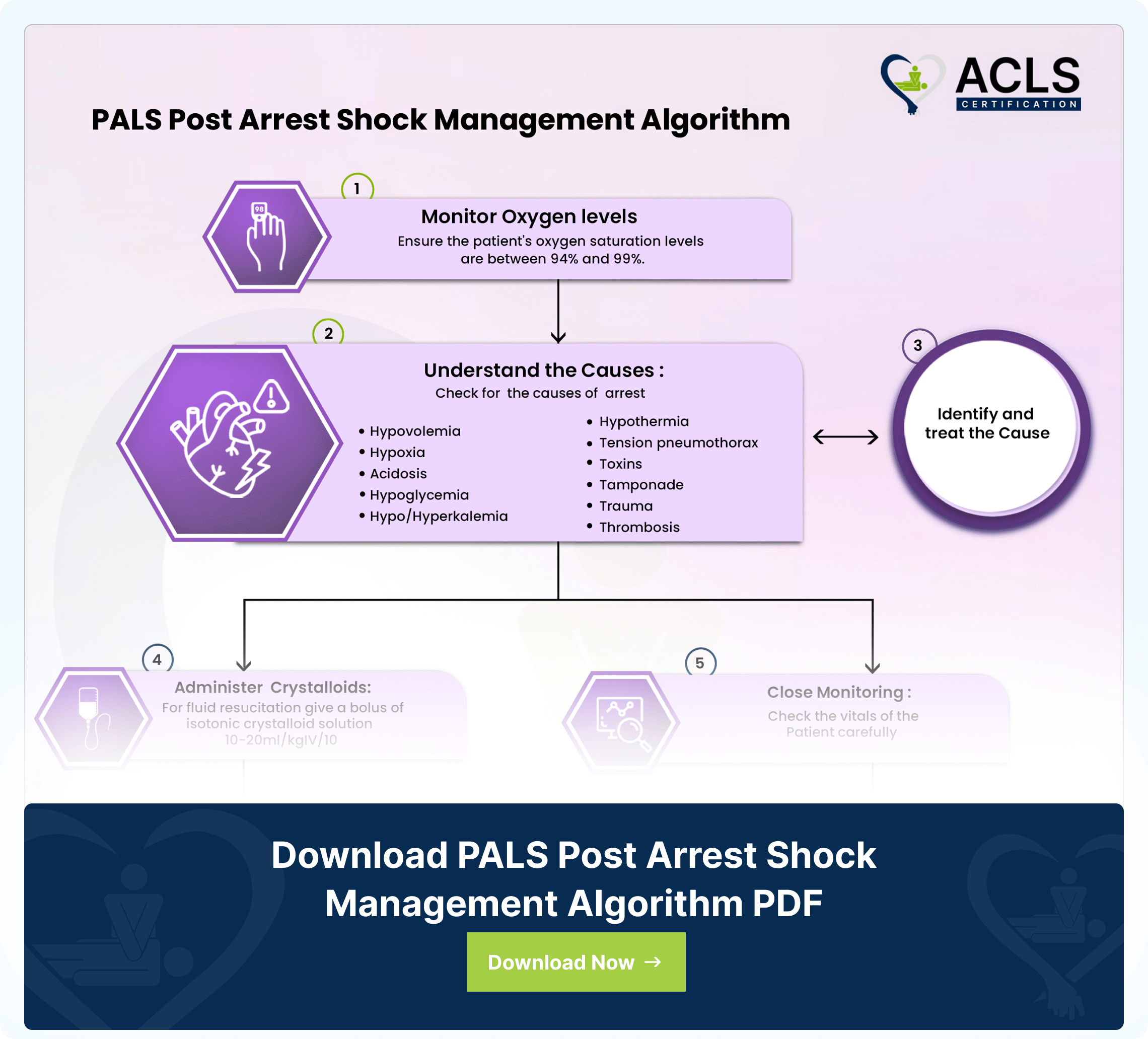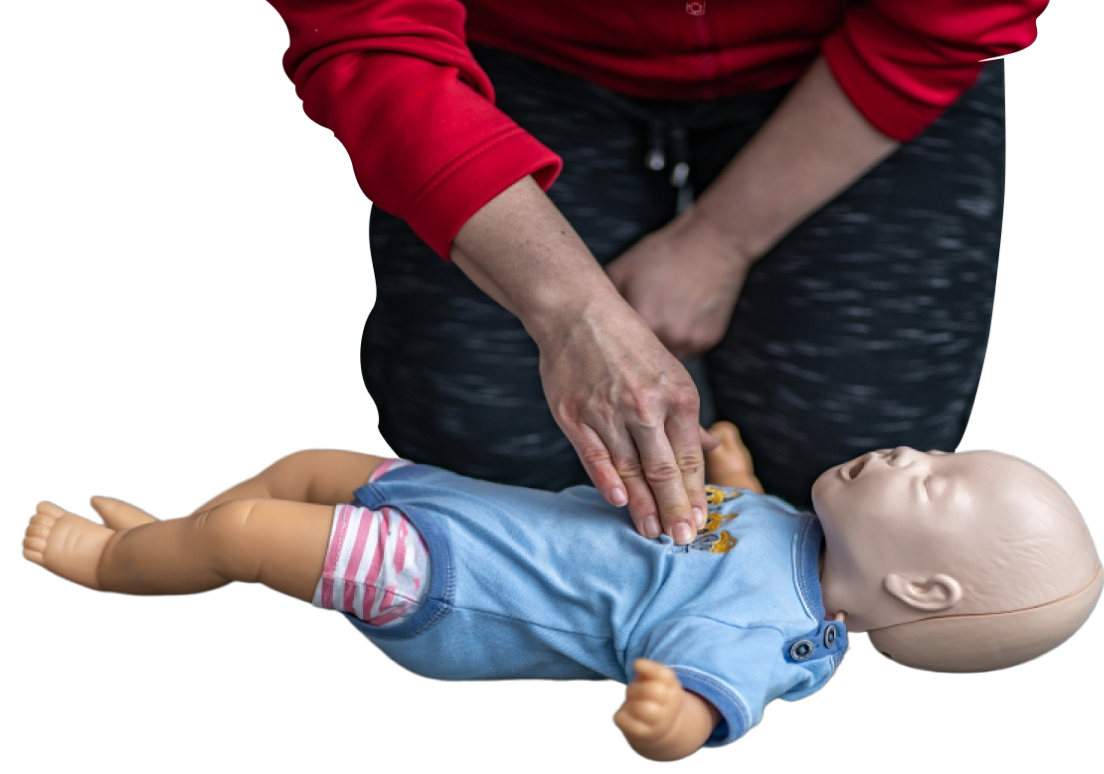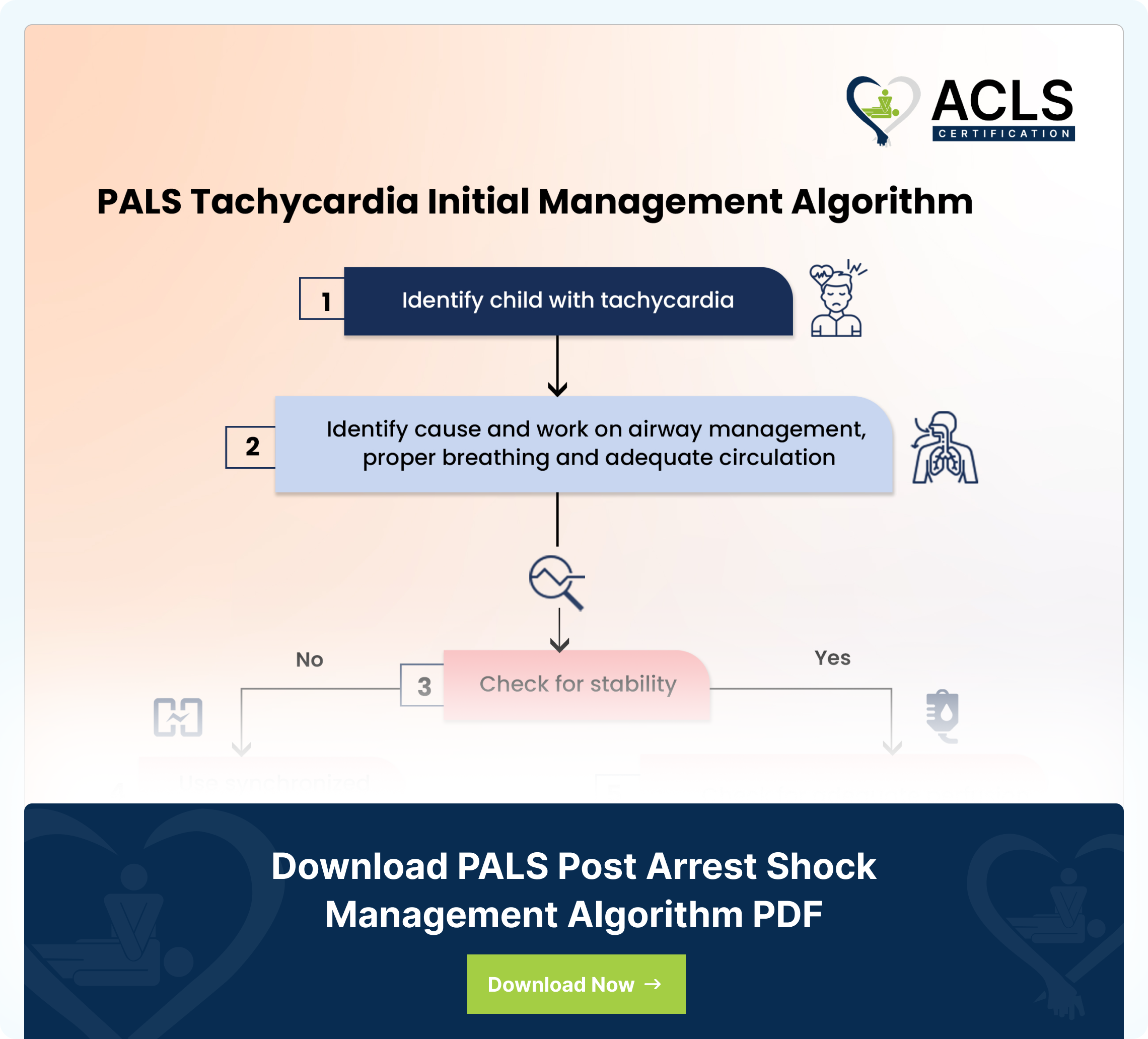The PALS (Pediatric Advanced Life Support) Tachycardia Initial Management Algorithm offers healthcare providers a structured approach to recognize and treat pediatric patients with tachycardia. It involves evaluating the patient's clinical condition, along with identifying signs of poor perfusion and categorizing the tachycardia as narrow or wide complex. Based on this diagnosis, interventions such as vagal maneuvers, adenosine administration, synchronized cardioversion, or professional consultation may be recommended. This algorithm ensures timely management which improves patient outcomes.
Explanation of the Flowchart
- Scene Assessment: Identify age and heart rate while determining the proper assessment of tachyarrhythmia.
- Early Management:
- Obtain IV/IO access
- ECG; cardiac monitoring
- Vital signs
- Administer oxygen
- Ensure patient has pulse
- Check for Stability: Once done, see if the patient is stable.
- Assess for Poor Perfusion
- Acute altered mentation
- Hypotension
- Shock signs
- Perfusion Check: If the patient is stable
- If yes: Consider adenosine, vagal maneuvers
- If No: Consider adenosine, synchronized cardioversion
- PALS Tachycardia Poor Perfusion Algorithm: If perfusion is inadequate, follow PALS Tachycardia Poor Perfusion Algorithm.
- QRS: If you find adequate perfusion, check QRS
- PALS Narrow QRS Tachycardia Perfusion Algorithm: If QRS is narrow, follow the PALS Narrow QRS Tachycardia Perfusion Algorithm
- PALS Wide QRS Tachycardia Perfusion Algorithm: If QRS is wide, follow the PALS Wide QRS Tachycardia perfusion Algorithm
Key Highlights
- Heart Range
| Age Group | Normal Heart Rate (bpm) |
| Newborns (0 to 1 month) | 70 to 190 beats per minute (bpm) |
| Infants (1 to 12 months) | 80 to 160 bpm |
| Toddlers (1 to 3 years) | 80 to 130 bpm |
| Preschoolers (3 to 5 years) | 80 to 120 bpm |
| School-age children (6 to 12 years) | 70 to 110 bpm |
| Adolescents (13 to 18 years) | 60 to 100 bpm |
**These ranges are general guidelines, and individual variations may occur. Consult a healthcare provider for specific concerns about your child’s heart rate.
- Tachycardia: Pediatric tachycardia is a condition when the heart beats rapidly. Tachycardia is a heart rate greater than the normal range. Which is over 100 beats per minute for a child. The reasons for pediatric tachycardia can vary. It includes fever, dehydration, stress, anemia, or underlying heart conditions.
- ABC Management Technique: In managing tachycardia, following the ABC technique is a must:
- Airway: Ensure that the child’s airway is open. Clear any obstructions, such as foreign objects or fluids, to maintain proper airflow to the lungs.
- Breathing: Assess the child’s breathing to ensure smooth ventilation. If there is any distress, provide appropriate interventions, such as rescue breaths or supplemental oxygen, to support breathing.
- Circulation: Evaluate the child’s circulation. Check for a pulse and assess their overall perfusion.
- Cardioversion: In PALS (Pediatric Advanced Life Support) guidelines, cardioversion is a treatment option for unstable tachycardia. It involves delivering a synchronized electrical shock at a specific point in the cardiac cycle to restore normal sinus rhythm. Cardioversion is usually performed under sedation or anesthesia. This minimizes discomfort and mitigates risk associated.
- Perfusion: In PALS (Pediatric Advanced Life Support) guidelines, perfusion means the adequacy of blood flow to vital organs during tachycardia.
- How to check for perfusion?
To diagnose perfusion, check the child’s mental status for alertness. You should observe skin color for pallor, measure capillary refill time (<2 seconds), assess pulse strength and regularity, monitor urine output (1-2 ml/kg/hr), and measure blood pressure in older children. Promptly seek medical attention if signs of poor perfusion are present. - QRS: QRS complex duration is an important consideration especially when it comes to evaluating tachycardia rhythms. Wide QRS complexes (>0.09 seconds) in tachycardia may indicate the presence of an underlying abnormal rhythm, such as ventricular tachycardia, which requires immediate treatment. Narrow QRS complexes, on the other hand, may suggest supraventricular tachycardia, which requires a different approach. Therefore, assessing the QRS complex duration is critical in determining the appropriate treatment pathway.
Download PALS Tachycardia Initial Management Algorithm PDF
Source
- Part 12: Pediatric Advanced Life Support: 2015 American Heart Association Guidelines Update for Cardiopulmonary Resuscitation and Emergency Cardiovascular Care https://www.ncbi.nlm.nih.gov/pmc/articles/PMC6191296/
- Supraventricular Tachycardia https://www.ncbi.nlm.nih.gov/books/NBK441972/
- Synchronized Electrical Cardioversion https://www.ncbi.nlm.nih.gov/books/NBK482173/
- Pediatric advanced life support and sedation of pediatric dental patients https://www.ncbi.nlm.nih.gov/pmc/articles/PMC5564122/
All PALS Algorithms

PALS Bradycardia Algorithm
The Pediatric Advanced Life Support (PALS) Bradycardia Algorithm gives a systematic approach to managing slow heart rates

PALS Narrow QRS Tachycardia Adequate Perfusion Algorithm
The PALS Narrow QRS Tachycardia Adequate Perfusion Algorithm gives a structural approach for managing pediatric cardiac emergencies. The algorithm ensures effective treatment to maintain adequate perfusion in pediatric patients.

PALS Post Arrest Shock Management Algorithm
The PALS Algorithm Stabilizes pediatric patients’ post-cardiac arrest optimizing recovery through targeted interventions



